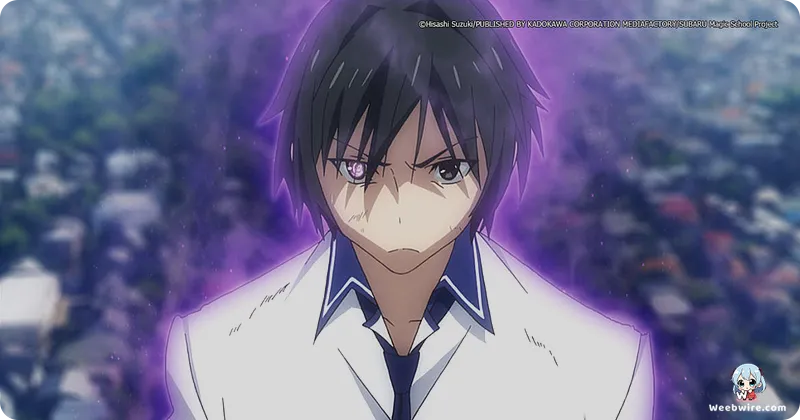Inside 'Magical Warfare': MADHOUSE's Bold Adaptation Choices Spark Enduring Fan Discussions

Released in 2014, the anime sensation Magical Warfare (Mahou Sensou) plunged audiences into a captivating realm of action, fantasy, and intricate magic. Brought to life by the esteemed animation powerhouse MADHOUSE, the series adapted Hisashi Suzuki's acclaimed light novel saga, illustrated by Lunatic. While its initial debut garnered considerable attention, a closer examination of its production and subsequent reception unveils a fascinating tapestry of creative decisions and their impact, firmly cementing its unique, and at times controversial, standing within the anime landscape.
A Divergent Narrative Path
A pivotal and widely debated aspect of Magical Warfare remains its significant narrative departure from its source material. As the anime progressed, particularly in its climactic arcs, the production team opted for an entirely original ending, veering sharply from the light novels' ongoing storyline. This bold creative choice ignited fervent discussions among fans, especially those deeply familiar with Suzuki's original vision. Many viewers found the anime's conclusion abrupt and felt it left numerous plot threads frustratingly unresolved, a stark contrast to the light novels' more expansive and meticulously developed narrative. While crafting original endings is not uncommon for anime adapting ongoing source material, the sheer extent of Magical Warfare's divergence made it a prominent talking point, profoundly shaping both critical and fan reception.
MADHOUSE's Artistic Hand
MADHOUSE's involvement as the animation studio adds another layer of intrigue. Renowned for a sterling portfolio that includes masterpieces like Death Note, Hunter x Hunter (2011), and the inaugural season of One-Punch Man—all celebrated for their impeccable production values, fluid animation, and faithful adaptations—Magical Warfare presented an intriguing case study. Despite the generally solid animation quality inherent to MADHOUSE's work, the controversial narrative decisions often overshadowed the studio's technical brilliance in the eyes of some viewers. This dynamic underscores the complex interplay between a studio's reputation for visual excellence and the overarching narrative direction of a project, demonstrating that even an industry titan like MADHOUSE can navigate challenges in satisfying all facets of an adaptation, particularly when substantial creative liberties are embraced.

Characters and World-Building
At its heart, Magical Warfare introduces Takeshi Nanase, a seemingly ordinary high school student burdened by a shadowed past. His life takes an extraordinary turn following a fateful encounter with Mui Aiba, a magical girl whose presence inadvertently transforms him into a formidable magician. This sudden immersion into a clandestine world of magic, replete with its own academies, warring factions, and ancient conflicts, forms the compelling backbone of the series. The Subaru Academy of Magic, where Takeshi and other budding magic-wielders hone their abilities, provides a rich backdrop for exploring diverse magical disciplines and the moral ambiguities of a world teetering on the brink of war. Takeshi's initial cynicism, born from personal trauma, slowly yields to a burgeoning sense of responsibility as he navigates the treacherous currents of magical politics and high-stakes battles, embodying a classic hero's journey amidst a fantastical setting. Mui Aiba, serving as both his guide and fellow combatant, epitomizes the strength and unwavering resolve characteristic of magical girl archetypes, yet she carries her own vulnerabilities and motivations intrinsically linked to the escalating conflict.
An Intricate Magic System
Furthermore, the series meticulously constructed an intricate magic system, categorizing magic into distinct forms such as the 'Magic of Destruction' and 'Magic of Spirit,' each boasting unique properties and applications. This detailed world-building, faithfully inherited from the light novels, provided a robust framework for the exhilarating magical duels and strategic confrontations that defined much of the action. The underlying, high-stakes conflict between the two dominant magician factions—the Witches, dedicated to restoring magic to the world, and the Wizards, committed to keeping it concealed—laid the groundwork for complex ethical dilemmas and visually stunning battles. The anime's exploration of these profound themes, though occasionally constrained by its condensed narrative, offered tantalizing glimpses into a richly imagined universe where power, destiny, and the profound consequences of war are central and recurring tenets.
Legacy and Lasting Impact
Despite the divided opinions regarding its narrative fidelity, Magical Warfare endures as a notable entry for aficionados of action-fantasy anime from the mid-2010s. Its unique position as an anime from a premier studio that intentionally forged a significantly divergent path from its source material offers invaluable insights into the creative processes and inherent pressures within the animation industry. The anime, while presenting a self-contained story, also serves as an accessible gateway for many to delve into the more extensive and ultimately concluded narrative of Hisashi Suzuki's original light novel series, thereby providing two distinct yet interconnected experiences of the same enchanting magical world. It stands as a powerful testament to how, even within a single franchise, different adaptations can offer varied interpretations and outcomes, each contributing indelibly to the overall legacy and ongoing discourse surrounding the work.
Credits
Magical Warfare
Author
Hisashi Suzuki
Cover Art
Lunatic
Studio
MADHOUSE
Publisher
Media Factory
Producers





